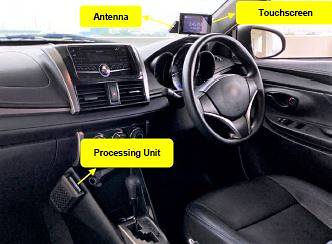SINGAPORE: The Land Transport Authority (LTA) is studying whether data from the new on-board unit (OBU) in vehicles can be pushed to smartphones, allowing them to be used as an alternative display screen for electronic road pricing (ERP) information.
This is a “possible future upgrade” for the OBU, said Senior Minister of State for Transport Amy Khor in Parliament on Monday (Oct 5).
It was announced last month that installation of the OBU – replacing the current in-vehicle units (IU) – will start in the second half of 2021. These will be used when Singapore switches to the satellite-based next-generation ERP system in mid-2023.
Dr Khor said authorities are consulting workshops and authorised motor vehicle agents on how best to install the OBUs.
“For example, the OBU display unit can be installed in cars such that the blockage of the windscreen is very minimal, and can be folded away,” she said.
“As for what to show on the display unit, indeed it should not be distracting and affect safety. LTA intends to present a few options to gather public feedback. For example, the display can be kept black most of the time, and only display ERP charges paid when a transaction is effected.”
READ: New ERP units to be installed from second half of 2021; no change yet to congestion pricing framework
Dr Khor was responding to questions from several Members of Parliament who asked whether the design of the OBU can be improved, whether the screen will be distracting for motorists and whether the majority of its functions can be replaced by a smartphone in future.
SECURITY FEATURES, OPERATIONAL CONCERNS
Explaining the design of the unit, Dr Khor said the Cyber Security Agency of Singapore had advised that the core charging transactions and ERP data must be “safely and securely processed with high assurance”.
The OBUs have therefore been designed to “uphold the necessary protection for such purpose”, with security features superior to that of a mobile phone, she noted.
The size of the OBU is only “slightly larger” than the current IU, Dr Khor said.
She added that with the exception of motorcycles, the processing unit in vehicles will be installed below the dashboard and separated from the display unit on the windscreen because of heat concerns.
“This is necessary because the OBU uses Global Navigation Satellite Technology and is really a little computer,” she explained.
“There will be safety and reliability issues to leave the processing unit on the dashboard when vehicles with enclosed spaces are parked under the hot sun, similar to how we will not expose our smartphones that same way.”

The new on-board unit for vehicles that are not motorcycles. (Photo: LTA)
Dr Khor also pointed to possible operational issues with the use of smartphones.
“Motorists need to remember to bring their smartphones, ensure it is sufficiently charged, is connected to the cellular network, and the ERP payment app is launched throughout the journey,” she said.
“There are bound to be numerous unintended failed transactions and inconveniences caused. Hence, LTA concluded that it is better to process payments through a dedicated and integrated OBU, similar to today’s in-vehicle unit (IU).”
READ: New ERP units: Transport Minister Ong Ye Kung addresses 7 common questions from motorists
Dr Khor said that for the new ERP system to be implemented smoothly, standardised display screens would have to be used.
She pointed to the urgency of putting the next-generation ERP into place, noting that with the existing gantry-based system reaching the end of its operational life, maintenance is increasingly difficult and expensive.
“Let the system stabilise, we will look at (the use of smartphones) and then when it is possible, we’ll be able to offer it to the motorists and they can replace their display unit. And for new car owners, they can actually opt for that in future,” she added.
READ: The new tech driving traffic on Singapore’s roads
Responding to Sengkang GRC MP He Ting Ru who asked whether public consultation was done on the design of the OBUs, Dr Khor said there were “practical constraints” in doing so.
Noting there is currently no similar system in the world, the Senior Minister of State said that LTA was contractually bound after the tender was awarded.
“(LTA) could have specified that the winning tenderer has to conduct a major public consultation exercise, and make significant changes to the design to take in public feedback, but that will add significant uncertainty which will delay the project and push up the tender prices,” she said.
Ms He later asked whether “greater flexibility” could be afforded for future tenders, given the rapid advancements in technology.
Dr Khor said the Government is mindful of possible technological advancements.
She added that there is room for consultation in the project, noting the appointed contractor had conducted internal consultations as well as engaged the Nanyang Technological University to conduct a “human factor study” on what should be included in the graphical user interface, including studying the safety of the display for drivers.




